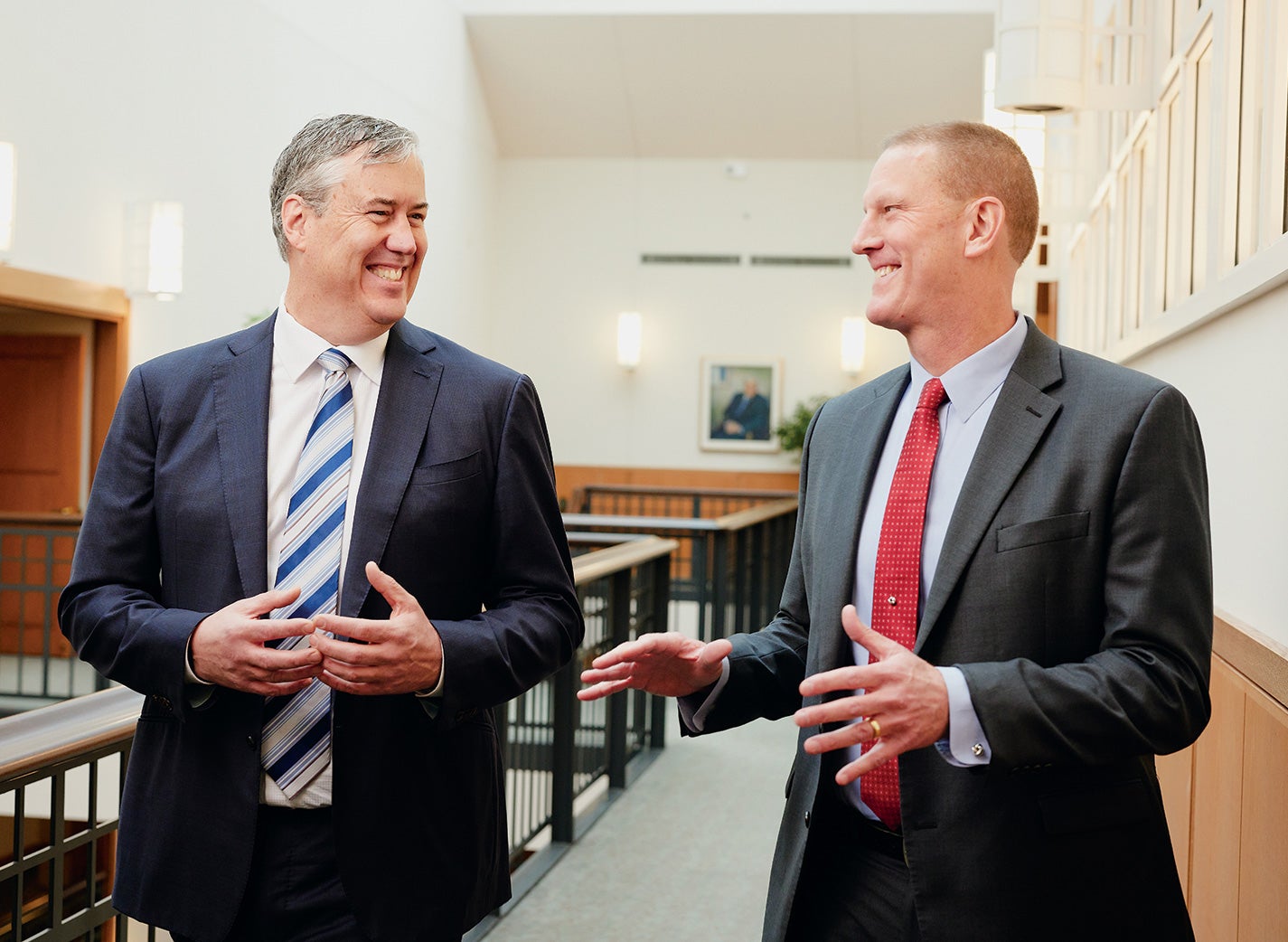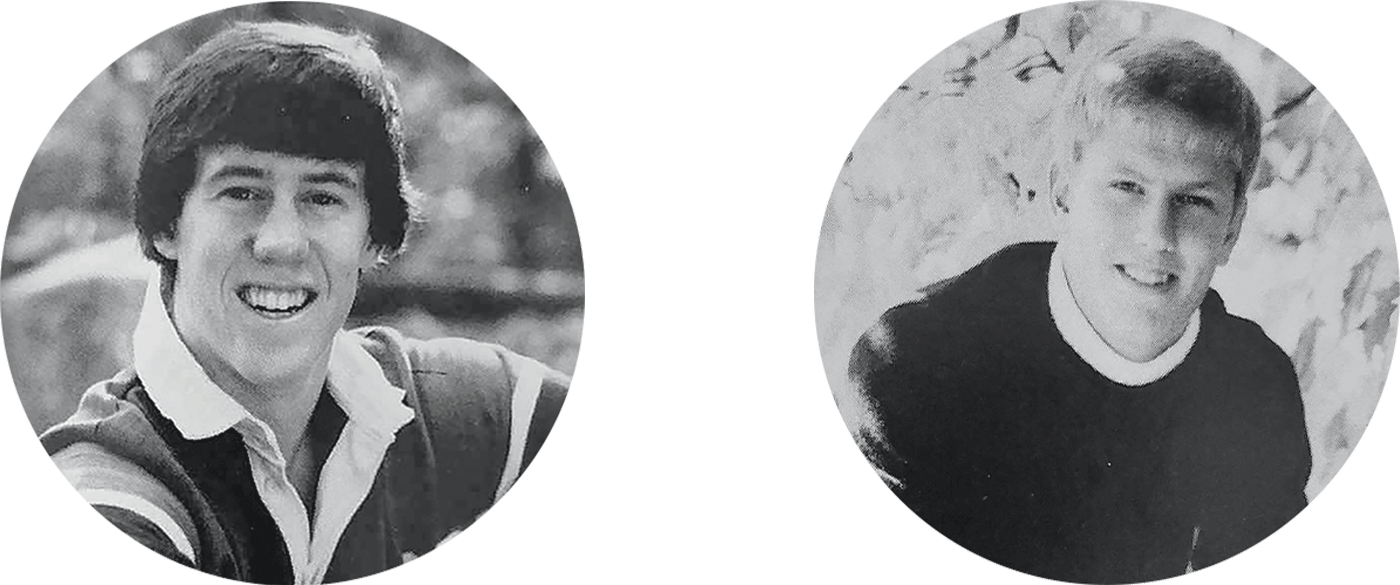lens
Together Again
Decades later, childhood friends reunite in senior roles at CWRU
 Photo: Angelo MerendinoMichael Oakes (left) and Dean Tufts easily renewed their friendship after decades apart, bantering through a recent interview with affection and light-hearted verbal jabs.
Photo: Angelo MerendinoMichael Oakes (left) and Dean Tufts easily renewed their friendship after decades apart, bantering through a recent interview with affection and light-hearted verbal jabs.
Michael Oakes and Dean Tufts grew up together in a small town in western Massachusetts. They rode bikes to each other’s houses, played Little League Baseball and had sleepovers—typical fifth- and sixth-grade stuff. After graduating from Longmeadow High School in 1985, though, they lost touch—other than a brief hello at their 20-year reunion.
A first-generation college student, Oakes went on to become a highly accomplished scholar, publishing more than 140 peer-reviewed articles on topics such as how college education affects population health, how dairy milk cows can more safely give birth and fundamental problems in some widely used statistical models involving factors that impact health.
Tufts, meanwhile, had a distinguished 30-year career in the U.S. Navy’s Civil Engineer Corps, leading teams and projects in Japan, Iraq, Afghanistan, Hawaii, California and, ultimately, the Pentagon.
Now, more than 35 years after graduating from high school, they’re together on the Case Western Reserve campus—Oakes as the university’s inaugural senior vice president for research and technology management, and Tufts as vice president for campus planning and facilities management.
We asked the two to reflect from their lofty heights—Oakes is nearly 6 feet, 7 inches; Tufts is 6 feet, 6 inches. (This will matter as you read on.)
Michael Oakes (MO): I put myself through college [dishwashing and painting houses]. It really wasn’t until junior year of college at the University of Massachusetts, where I stumbled on some other students and professors who were working on problems that excited me. Without any prior understanding of it, I fell in love with scientific research and the ability to discover things in the world—this is important for me—to make it better.
Dean Tufts (DT): My folks could have paid for my college, but I wanted to do it myself. So I asked my high school guidance counselor, ‘Hey, how do I do this?’ [He said] ‘Well, have you thought about going military? You can go to a service academy, or you can go ROTC.’ So the plan was go to Cornell [University] and then do my four years in the military and get out and be an aerospace engineer. Got into the Navy and I just really liked the military atmosphere; how everybody was pulling on the same end of the rope all the time for a bigger mission.

We couldn’t resist including the high school yearbook photos of Michael Oakes and Dean Tufts.
DT: One of the co-leaders [of the corporate-recruiting group] said to me, ‘Oh, there’s another person that is coming to Case [Western Reserve] He’s a really great guy, and he’s tall also.’ Which, you know, my first reaction was all tall people know each other. So I kind of laughed and said, ‘That’s great.’ And she said, ‘I think he’s from western Massachusetts, around Springfield.’ Well, now it gets really interesting. One thing leads to another, and I realize it’s Michael Oakes.
MO: Well, from my side, I hear the scuttlebutt that another tall person is being recruited. I’m sitting in my office one day, cleaning up my stuff at the University of Minnesota ready to come here, and I got a text out of the blue, ‘Hey, Mike. I’m coming to Case [Western Reserve], too. Looking forward to working with you and catching up [and it was signed], Dean.’ And I was like, catching up? That’s so weird. And then he said, ‘LHS ’85,’ and I knew immediately, and it just delighted and shocked me. And I’ll tell you what struck me: He texted, ‘How are you moving? Let me know if I can help you in any way.’ Haven’t seen him in 37 years. And he’s the same tremendous person.
DT: You said the same thing.
DT: Well, I’m fairly religious, so I think there’s a little bit of fate in there, a little hand in there.
MO: I’m an applied statistician; taught statistics for 20 years. So the odds are infinitesimally small, true. But these are the kinds of things you’re like, well, how’d that work out?
MO: My job has many metrics, [including] the amount of research expenditures and the satisfaction of the faculty—to make sure they can do their creative, interesting work. There are metrics about building the prestige of the institution; serving my boss, President [Eric W.] Kaler, and making sure I’m executing his agenda; being a good colleague; and being a good friend to folks in the Greater Cleveland community.
DT: Over the next four or five years, we’re going to be doing some major things for this university [that are] clear priorities of the president. It’s really good to work with somebody who you inherently trust immediately. Ultimately, I measure my success [based on] how successful this university is. If it’s an increase in research expenditures, if it’s academic standards, if it’s community outreach—any of those things—hopefully, my folks have a small part in that. We’re not here to build a building, clean office space and cut the grass. We’re here to create academic excellence for our students, to create research excellence for our faculty and to create outreach for our community. That’s what we’re here for.





